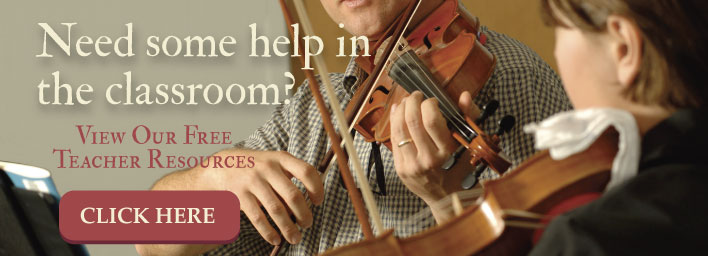Techniques For Teaching Vibrato

Developing a beautiful and expressive vibrato is one of the major distinctions that separate beginner students from mature violinists, cellists, and other string musicians. Vibrato is what characterizes the uniquely warm, rich tones of a stringed instrument, which are so different from the straight tones produced early during the learning process. However, even students who have been playing for years often struggle with perfecting their vibrato technique.
Vibrato is a purely personal expression. It involves motion, feeling, and mechanics, which combine to create a sound that springs from the individual character and soul of the musician; and the personal interpretation of the music created through it is as distinguishing as the human voice. However, because vibrato is such a personal technique and can be produced through finger, hand, or arm movements, teaching styles and methodologies vary.
The strategies for teaching vibrato included here are a compilation overview of some of the most wide-spread techniques. By incorporating these ideas into your own unique approach, you can help your students develop this very important stringed instrument skill and renew their enthusiasm for playing.
Setting the Stage
Learning vibrato is just like learning to play an instrument or developing any other skill, it requires the proper conditions; and success depends largely on ensuring that the fundamental basics are being strictly followed. For example, you can certainly learn to hit a baseball with one hand holding the bat, but it’s much easier to succeed when you apply the proper stance and holds. The same concept is true for learning vibrato. As a fundamental stringed-instrument skill, ensuring that certain conditions have been met before you attempt to impart it will make it easier for both you and your students.
Phillis Young, former president of the American string Teachers Association (ASTA) and professor at the University of Texas in Austin, is a respected authority on teaching vibrato. Her books and various speaking engagements, which are designed to share vibrato-teaching techniques with other music instructors, emphasize preparation. That wavering effect of tone which transforms a flat pitch into an emotional, vibrant sound takes time to master. Before you can teach it, your students need to have a firm grasp on certain basics to ensure that they are ready for it. Assess on a case-by-case basis:
- Intonation and knowledge of the fingerboard—knowing exactly where a note is located and how it sounds is an important part of learning vibrato. Assurance in this area is crucial to success.
- Relaxed playing—too much tension in the thumb, joints, and elbow will make it difficult to produce clear vibrato.
- Can the student project wide tones?—learning vibrato is easier if the student is able to sustain big, vibrant tones. Starting out with a wide, free motions makes it simpler to refine the technique later.
Practicing Tips
There are many different exercises that you can utilize to demonstrate how to produce vibrato. And although the techniques are similar, the methods you employ to teach your students will naturally be dictated by the type of instrument being played. You can find free resources, games, and exercises by joining the ASTA or scoping out videos online, but it’s also worth mentioning that vibrato is so subjective that the main concepts you’ll want to stress can be classified as practicing goals, rather than rules.
- Hearing correctly—it’s easier to make the mental connections needed to produce beautiful vibrato if the student can clearly recognize when the vibrato begins. As mentioned, students should produce a long clear bow stroke, but begin the vibrato only after two beats so that they can perceive what is happening with the muscles in their arm. The combined vibrations and sound will create mental associations that are a crucial aspect of learning this skill.
- Concentrate on Flexibility—this cannot be stressed enough: relaxed muscles, loose joints and knuckles are very important, and student motions should be deliberate.
- Slow and Steady—keep the tempo very slow, and have students practice vibrato while playing their best, clearest note; and have them pay particular attention to the balance of the playing finger
While teaching methods differ depending on the instrument, you can help your students develop vibrato by trying various “helping” techniques such as holding the scroll of the violin for support or gently tugging on the student’s elbow while the student “feels” the springing motion that generates vibrato. However, the most important aspect to keep in mind is that learning vibrato is different for everyone. By adapting your teaching methods to your student’s needs, you’ll be able to find a technique that works best for that individual and produces great results.


